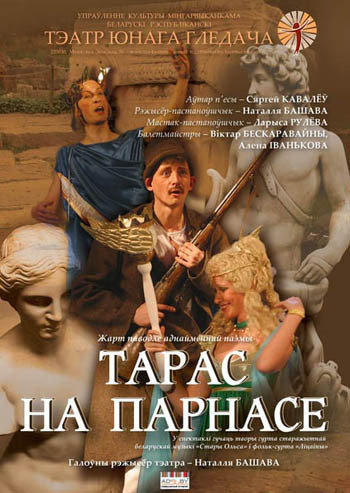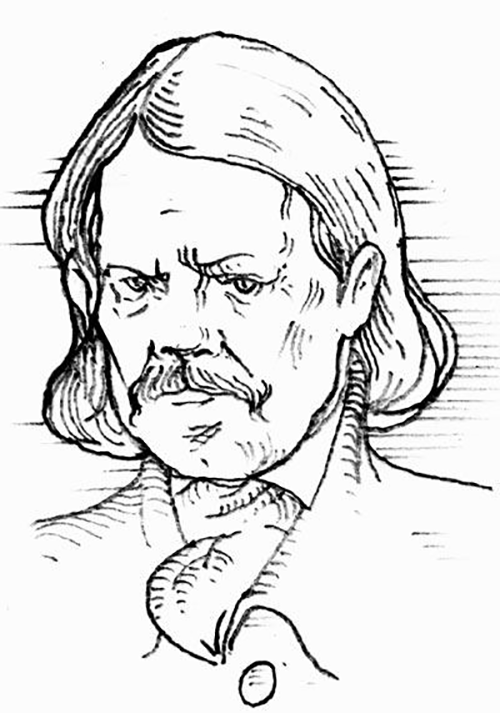Title of the work
Studio / Production Company
Country of the First Edition
Country/countries of popularity
Original Language
First Edition Date
First Edition Details
Taras on Parnassus. Directed by Natallia Bashava, stage adaptation by Siarheĭ Kavalioŭ, based on a poem by Kanstantsin Veranitsyn, set design and costumes by Larysa Ruliova, choreographers – Viktar Beskaravaĭny, Alena Ivan’kova, Minsk, Belarus: Belarusian State Academic Theatre For Young Audience, 2004, 130 min.
Running time
Format
Official Website
www.beltuz.by (accessed: July 15, 2018)
Available Onllne
https://www.youtube.com/watch?v=fg1UpZfajsY, Published on Feb 2, 2011;
https://www.youtube.com/watch?v=RaZMiGhgnNs, Published on Feb 2, 2011.
performance excerpts, MinskTUZ Official YouTube channel (accessed: July 15, 2018).
Genre
Comedy films
Humor
Target Audience
Young adults (age recommendation 16+)
Cover

Taras on Parnassus. Courtesy of Belarusian State Academic Theatre For Young Audience
Author of the Entry:
Maria Pushkina, National Academic Janka Kupała Theatre, maryiapushkina@gmail.com
Peer-reviewer of the Entry:
Elżbieta Olechowska, University of Warsaw, elzbieta.olechowska@gmail.com
Elizabeth Hale, University of New England, ehale@une.edu.au

Natallia Bashava
, b. 1976
(Director)
Natallia Bashava (Наталля Башава) is a theatre director and educator. She graduated from the Belarusian State Academy of Arts in 1996. She used to be the artistic director of the Belarusian State Academic Theatre For Young Audiences.
Sources:
official page on the Belarusian State Academy of Arts website (accessed: October 15, 2019).
Bio prepared by Maria Pushkina, National Academic Janka Kupała Theatre, maryiapushkina@gmail.com

Siarheĭ Kavalioŭ
, b. 1963
(Author)
Siarheĭ Kavalioŭ (Сяргей Кавалёў) is a playwright and literary critic. He was born in 1963 in Mahilioŭ. He graduated from Belarusian State University in 1985 and started to work there as a lecturer at the department of History of Belarusian Literature. Nowadays he lives and works in Lublin (Poland), he is professor and head of Slavonic Studies Institute of Maria Curie-Skłodowska University.
Sources:
www.umcs.pl (accessed: October 15, 2019).
Bio prepared by Maria Pushkina, National Academic Janka Kupała Theatre, maryiapushkina@gmail.com

Courtesy of Siarhei Khareŭski.
Kanstantsin Veranitsyn
, 1834 - 1904
(Author)
Kanstantsin Veranitsyn (Vasil’eŭ; Канстанцін Вераніцын, Васільеў) was born in Astraŭliany village (Vitsebsk region, Belarus) into a family of serf peasants, who were owned by the landlord Vasil’ Bondaraŭ. At the age of eleven Kanstantsin received freedom and aquired his surname Veranitsyn. It is quite possible, that Kanstantsin Veranitsyn was an illegitimate son of his landlord. He went to the parish school of Haradok, Vitsebsk provincial gymnasium (1845–1852) and studied at St. Petersburg Medical and Surgical Academy (1852–1854). In 1854 Veranitsyn was expelled from the Academy, but in 1859 he graduated from Horki Agricultural Institute with his final work “On the Belarusian economy”. In 1863-1874 he lived and worked in St. Petersburg, in 1874-1879 he worked as a teacher at Maladzechna Teachers' Seminary. Since 1880 he worked for the Ministry of Railways in St. Petersburg in the rank of state councilor. The exact date of his death is unknown. Except Taras on Parnassus, there is only one poem (The two devils) that is thought to have been written by Kanstantsin Veranitsyn.
Sources:
Kisialioŭ, Henadz’ [Кісялёў, Генадзь], Жылі-былі класікі: хто напісаў паэмы Энеіда навыварат і Тарас на Парнасе [Once upon a time, classics lived here: who wrote “Aeneid Inside Out” and “Taras on Parnassus”], Minsk: Беларуская навука [Belaruskaia navuka], 2005.
Bio prepared by Maria Pushkina, National Academic Janka Kupała Theatre, maryiapushkina@gmail.com
Casting
Actors: Siarhej Marhovich (Taras), Natallia Harbacienka (Paraska, Hera), Marta Shantar, Liudmila Asmaloŭskaia (Zośka, Hebe), Vasil’ Kazloŭ (Seviaryn, Zeus), Voĺha Sinitsa-Hryshka (Veranika, Venus), Dzmitryĭ Abazovik (Hercules), Aliaksandr Hladki (Viktor, Mars), Aliaksandr Palazkoŭ (Achrem, Vulkan), Andrej Kalamiets (Symon, Apollo), Aliaksandr Palazkoŭ (Bazyl’ka, Bacchus), Hienadź Haranski (Cupid), Katsiaryna Krylova, Aliaksandra Kryvasheĭ, Hanna Kozel, Iryna Tsviatkova (Mechanical girls, Nymphs), Ivan Ushakevich, Andreĭ Karalevich, Pavel Tsierachaŭ (Poets, Satyrs).
Summary
This play is a presentation of the classic Belarusian poem Taras on Parnassus.To meet the needs of the production, the dramatist integrates the events of Taras’ family life into the plot of the classic poem Taras on Parnassus (Taras, a forester, got lost in the woods while hunting and found himself at Mount Parnassus, where he met the pantheon of ancient gods). The daughter of Taras and Paraska is getting married, but her father does not approve of her fiancé. According to the idea of a production team, the gods on Parnassus have their doubles in the village where Taras lives. A brief look at the list of characters proves that both types of roles (a peasant and a god) are performed by one particular artist. By the time Taras reaches Parnassus, Zeus leaves the mount for his own needs. All other gods fight with each other in his absence. They easily take Taras for Zeus. Taras agrees to restore order on the top of the mountain and resolves all the classical mythological issues quickly and easily. Suddenly Zeus appears. He thanks Taras for his support, and both characters arrange a big Grapevine Feast (Taras calls it Dazhynki / a Slavic harvest festival). Upon returning home, Taras notices that everything has changed for the better, specifically his daughter has chosen a right person to become her husband. Everyone celebrates the wedding. One can see “antique clothing” come out under peasant suits of the villagers.
Analysis
The play is based on the classical plot of the poem (although the poetic text itself is barely used) and contains some additional elements of ancient texts that were transformed by the playwright.
Additional motifs help to show the world of Parnassus in detail, make it more plausible and bright. So some additional characters serve the same aim. The most vivid mythological allusions arise in those scenes where Taras helps gods with their issues. Hercules tells the story of his twelve labors, Venus tells about her marriage to Vulcan, Hera mentions all the disguises of Zeus. However, the display of Parnassus pantheon is made in the manner of a travesty. This also applies to sets and costumes, they are made in an ironic, unrealistic manner. The performance highlights the idea of making a simple man get acquainted with the world of classical culture and state his right to be present on Parnassus, which is a common idea of the 19th-century literature.
The dramatic basis of the play is part of a hermeneutic project introduced by Siarheĭ Kavalioŭ. His goal is to enrich contemporary theater culture with the brightest examples of classical literary heritage, to revive forgotten ideas and plots. The performance demonstrates the reception of ancient motifs through simultaneous comprehension of national literary heritage of the 19th century. The performance occupies an important place in the repertoire of the Belarusian State Academic Theatre For Young Audiences and is remarkable for its educational and enlightenment goals. Taras on Parnassus is offered in school curricula, so it has already become a good tradition to visit theatre after discussing the poem in a class. Mythological figures of Olympian gods in the performance are presented in grotesque and burlesque terms. The chosen type of representation performs its educational function: young audiences could see basic elements of Olympian everyday life from the perspective of a poorly educated, but ingenious character, this way the performance introduces them the concept of irony, grotesque and satirical poem as a genre. It perfectly fits the age group of the target audience.
Further Reading
Kavalioŭ, Siarheĭ [Кавалёў, Сяргей], "Герменеўтычная драматургія, або актуалізацыя забытых сэнсаў" ["Hermeneutic drama, or actualization of the forgotten meanings" (Hermeneŭtychnaia dramaturhiia, abo aktualizacyia zabytych sėnsaŭ)], in Siarheĭ Kavalioŭ [Сяргей Кавалёў], Стомлены д’ябал. П’есы [The tired devil. Plays (Stomleny d'iabal)], Minsk: Логвінаў [Lohvinaŭ], 2004, 5–19.


